Text
Trip Downtown
This week I was able to explore downtown Chicago. Listed below are the unique and significant sites located in the city’s central core; all of which I was able to visit personally.
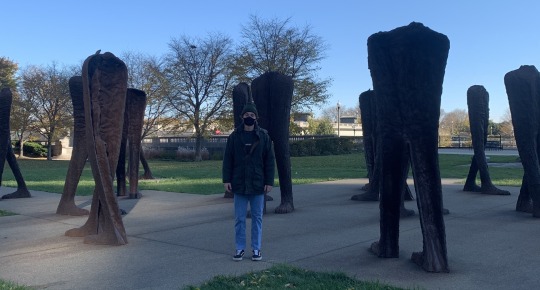
Agora Sculpture found at the south end of Grant Park

Grant Skate Park

John A. Logan Statue
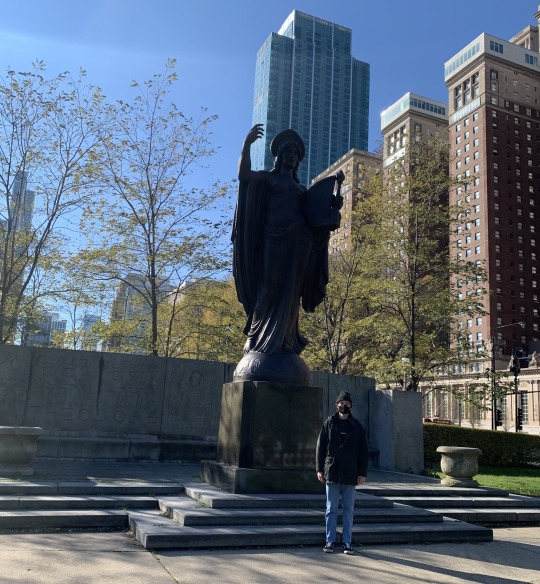
Spirit of Music, Theodore Thomas Memorial

Congress Hotel
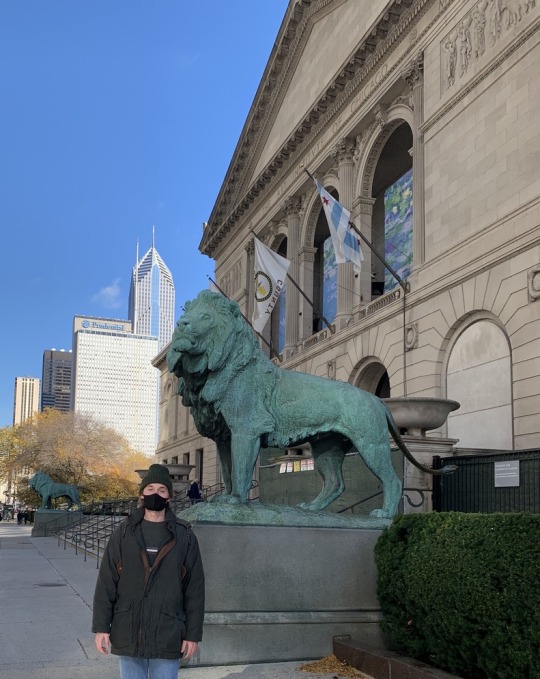
The Lions Of Michigan Avenue at the Art Institute of Chicago
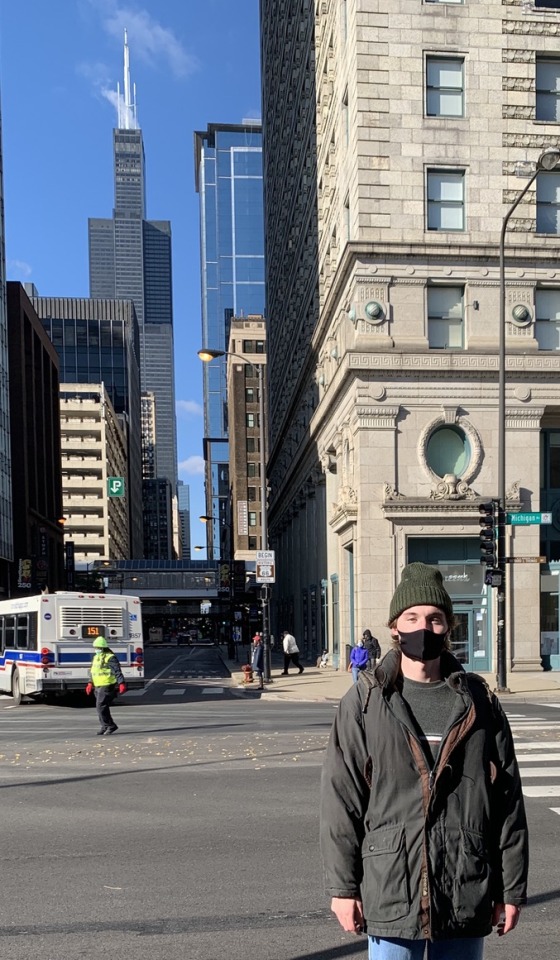
Beginning of Historic Route 66 at the corner of Michigan Avenue and Adams Street, Willis Tower in background
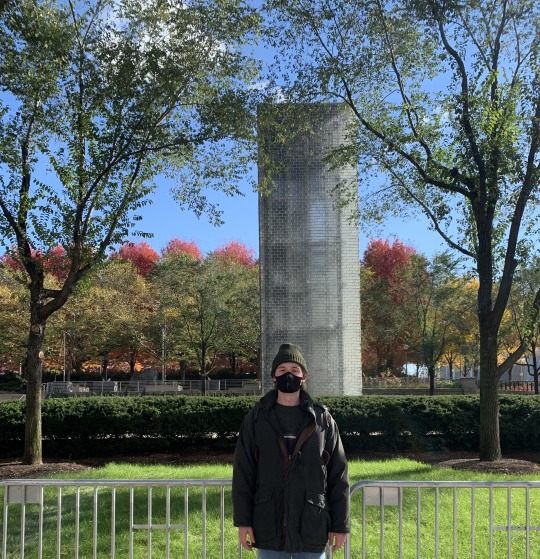
Crown Fountain located in Millennium Park
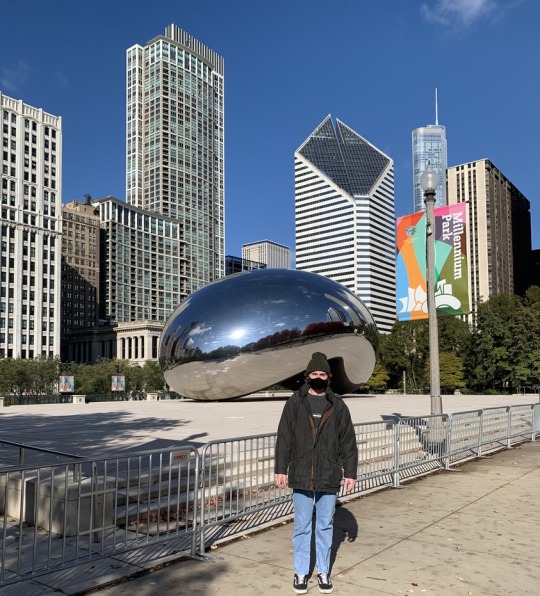
Cloud Gate Sculpture, popularly known as The Bean

Jay Pritzker Pavilion in Millennium Park
0 notes
Text
Trip to Pilsen
In continuation of my biweekly trips around the city of Chicago, I was able to tour the prideful Pilsen neighborhood. Pilsen is defined on its southern border by the south branch of the Chicago river. The east side of Pilsen is bounded by the interstate and railways, while the western edge does not have a strict border, it finds its imaginary barrier at Ashland Avenue. The neighborhood runs as north as 16th Street, just bordering Little Italy. Pilsen today is composed mostly of inhabitants of the Hispanic population. The demographics of the neighborhood are observed as seventy-one percent Hispanic, nineteen percent white, and the third largest race is the black community composing six percent of the total population (Statistical Atlas, 2020). It is clear that the neighborhood is dominated by a Hispanic influence, one example is exhibited by the preparation of the Hispanic holiday soon to come. Decorations litter the neighborhood, all of which may be atypical to a visitor who is unaware of the approaching celebration.

Map of Pilsen
Most neighborhoods in America can generally be assumed to celebrate Halloween, on October 31st, in which residents dress up into costumes and enjoy sweet treats. But unlike most neighborhoods, the residents of Pilsen are celebrating a different holiday this fall, the Día de los Muertos, or the Day of the Dead. Unlike Halloween which is a single night of celebration, Día de los Muertos is a multi day celebration of familial ancestry. During the three day holiday, the Hispanic community celebrates the life of late members; in which they believe, the gates of heaven are opened to allow for their families to rejoin them in the material world (History.com Editors, 2019). This holiday is a time of reflection and allows families to reverie their lost loved ones, and celebrate the future of the existing generation.

Colorful skulls on display for Día de los Muertos
Unlike today, the Hispanic population did not always dominate the neighborhood. Pilsen prior to the Great Chicago Fire in 1871, the neighborhood had a mix of early European immigrants, consisting mostly of enclaves of Irish and German descent. After the tragedy of the Great Fire, Chicago resurrected itself, characterized similarly to the mythical phoenix. The city transformed into a modern era, with newly created skyscrapers that marveled the world. Due to the fire, many inhabitants of the city found relocated housing because of the new structures that now filled their land. This demographic shift in neighborhoods allowed for the Bohemian immigrants to find their enclave.
The Bohemians, also, commonly referred to as
, or Czechs. The first rush of Czech immigrants came as refugees fleeing during the period of unsuccessful revolution in Austria-Hungary in the mid-1800s (CSAGSI, 2020). The second, larger, wave was enticed to travel to Chicago because of the persuasive governance, through the Homestead Act, as well as immigration treaties between the United States and Austria-Hungary. The introduction of these policies influenced skilled workers to Chicago, including craftsmen and artisans. A majority of the new wave was a motivated collection searching for social and economic stability.
After the fire, there was little development in the region, so the Czechs settlers were fortunate to inherit land with unlimited potential. Due to the location and physical barriers of the neighborhood, it allowed for the stimulation of an isolated, and self-sufficient Czech enclave. Because of the strict physical borders, the Czechs were able to raise a large population with ease of exclusiveness to the neighborhood (CSAGSI, 2020). With influence from strict borders, and cultural identity of self-sufficiency, the Czechs were able to construct what is to be considered, the center of the Czech-American world. This hub was extremely crucial to the Czechs up until 1918, when Czech independence was obtained. Because of the newly acquired independence, political persecution from the previous nation-state was no longer a motive to flee; this independence created the effect of declined Czech immigration in the early twentieth century.

View of Chicago skyline from Pilsen
By the 1950s the neighborhood began to change in demographics, with a majority of its previous Czech population moving west, and dispersing to the suburbs of Chicago. During this period of United States history, there was a new immigrating ethnic population, the Mexicans. The Czechs built the standing neighborhood , but the Hispanic population did a remarkable job at preserving the area. The ability of the neighborhood to service a large population and successful economic activities simultaneously made Pilsen extremely attractive to the new immigrants.
The Hispanics made it apparent they were there to stay; quickly they erected a Catholic Church, and in preceding years would infiltrate and hold positions in the neighborhood’s community council (Pupovac, 2018). Another way the new inhabitants claimed their neighborhood, is through artistic murals. All around the neighborhood, it is glaring that art is a central focus, and institution to the neighborhood. Along most open surfaces, and walls, vibrant and ornate murals can be seen, they depict imagery of Hispanic culture and the history of the community. It was clear from their settlement, that the Hispanic community was here to stay.

Peace (Metafisica) by muralist Mario Castillo, Halsted Street and 18th Street
The people that call Pilsen home are prideful of their neighborhood. They have a history of fighting for greater civic rights. The community has influenced positive changes in regards to poverty, violence, education for the neighborhood (Pupovac, 2018). As is a common denominator amongst many of the neighborhoods evaluated during my trips, gentrification threatens the lifestyles of current residents, as well as the economic functions of the neighborhood. Endangering the Pilsen that exists today is the rapid gentrification that is swallowing Chicago’s neighborhoods. The interests of outside investors and homeowners jeopardize the lives of many in Pilsen. Despite this looming threat, activists for the neighborhood still fight for environmental betterment of the area, preservation of the neighborhood, and advocacy for immigrants searching for better opportunity.
During my excursion of Pilsen I was able to observe religious institutions, a public garden, as well the countless murals littered throughout the neighborhood. Just a brief walkthrough of the neighborhood it is clear that the Hispanic community is highest in concentration. The shops and businesses all service to a Hispanic population. Some businesses are even entitled in Spanish, and others have both Spanish and English writings posted on window fronts. A majority of the shops consist of tertiary sector industries, primarily service based. Coffee shops, restaurants, and other service based businesses dominate the neighborhood's economic functions.
The first site I was able to see was quite unique, the Roman Catholic Church of Saint Vitus. The Church of Saint Vitus is actually no longer a functioning parish, instead the building was repurposed to serve as the Guadalupano Family Center. The family center was established with a daycare center for working families, and functions as well as a cultural center for the neighborhood. The renovation effects that took place in the mid-nineties was one of the greatest community reinvestments, with Pilsen residents raising over one and a half million dollars for the efforts (National Trust for Historic Preservation, 2005). What stands out from this family center is the generosity they bring to the community. Due to varying economic levels of the neighborhood, the daycare employs a non-fixed fee for patrons, as this can better aid low income families.
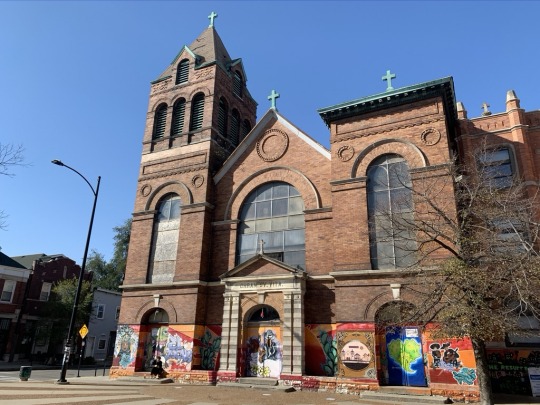
Roman Catholic Church of Saint Vitus, Guadalupano Family Center, 1814 South Paulina Street
To note on the building itself, it can be described as dominant. Standing at the corner of 18th Street and Paulina Street, it is a safe haven for families in the area. The center still utilized the same building structure as the parish before it. The most intriguing part of the building to me was the street art illustrated at the base of the building. Generally when seeing a church, an onlooker would not expect to see illustrations painted along its exterior walls, but as a repurposed building, the center takes advantage of its blank canvas to project imagery of Hispanic themed artworks.
Despite the discovery of this unique church, I was still able to visit a more traditional religious institution, as compared to the repurposed Guadalupano Family Center. The second parish I saw was the Catholic Church of Saint Pius V. This church has a far more traditional function, than the previously listed institution. Established in 1874, to serve Irish immigrants, the church has a history of excellence, with its school being the first Catholic institution to be accredited by Chicago Public Schools (Romulo, 2019). As the population demographic shifted in the neighborhood, so did the services at the Church of Saint Pius; beginning in 1963, the church offered mass in both the English, and now Spanish languages, to promote greater integration of the neighborhood (Romulo, 2019)). Still to the current day the parish functions for its Hispanic community still continuing its services in two languages.

Catholic Church of Saint Pius V, 1919 S Ashland Ave
The design of the building is similar to many other Catholic churches. It displays a singular large tower with a cross atop, and a longer reception hall that is capped by an inclined roof. The building itself is settled on an unfortunate plot, at the corner of Ashland Avenue and Cullerton Street. The combination of these streets brings heavy traffic just outside the doors of the parish. Although this does not take away from the beauty of the building, it did impact the overall experience, as it was difficult to hear anything beyond the cars that filled the streets. A final note, is it appeared repairs or renovations were being made to the building during the visit, this is telling as without neighborhood support the parish would not be able to afford such repairs.
During further exploration of the neighborhood I stumbled upon the pleasant surprise of the La Huerta Roots & Rays community garden. This community garden is a volunteer-ran garden in the Pilsen neighborhood. Originally targeted in 2008, only then an empty plot of land, one resident of the community, noted the site with neighborhood potential. What began as a few beds of perennial flowers and handful of vegetables the garden has transformed into an award winning space, occupied by twenty-five private plots, along with a perennial flower garden, fruit trees, and a community safe haven for residents to grow and harvest vegetation (La Huerta Roots and Rays, 2019).
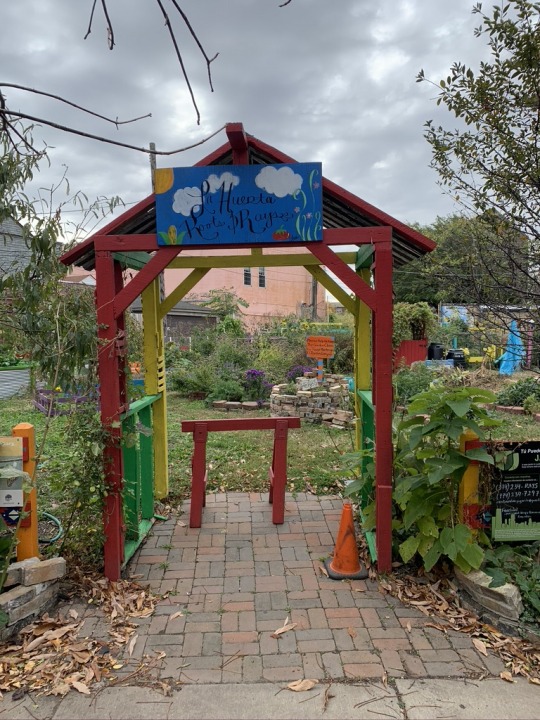
La Huerta Roots & Rays Community Garden, 1523 W Cullerton Street
Most telling of the garden is the neighborhood's sense of togetherness and pride. From the idea of a single individual, and the resourcefulness of the surrounding community an empty plot of land is transformed into a farming center for nearby residents. On the day of my visit the perennial garden was blooming with an array of colorful flowers. Located in the garden as well are food preparation and cooking spaces, as to promote a central gathering area for neighbors. The garden was very well maintained and it was apparent that the local residents valued this green space in their community.
Finally I would like to discuss the bountiful and beautiful murals located throughout Pilsen. When first entering the neighborhood it is obvious the importance of art to the neighborhood, and how the artist expresses their ideas through their artworks. A multitude of varying themes are illustrated by the artists, with murals with themes ranging from the history of the Hispanic population to purely creative pieces. On one wall there may be a mural depicting themes of peace while the wall adjacent has illustrations of the popular series, Pokémon. No matter what the art is expressing, it is valuable the neighborhood allows public displays of artistic expression. This expression symbolizes the mood and aspirations of the current population, and the continuation of their successes in the neighborhood.

Pokémon mural along 18th Street
Of the murals I observed most were located along 18th Street, with works illustrated on the walls of the elevated rail lines. Some parts of the wall are sectioned by theme, but as a total entity the wall has little design plan. More than likely going off the basis of first come, first served; the murals sometimes have very little relation to one another, but as an entity the wall looks full and colorful. The designs, although not considered classical talent, still require craftsmanship and skill. Many of the murals pay homage to Hispanic culture and history, but others just display scenes of creative randomness. Overall these murals play a vital role to the Pilsen community as artistic expression is one way to strengthen the community while promoting inclusion of new ideas.

Race to the death mural found along 18th Street
Reflecting on my trip to Pilsen what remains at the forefront of my experience were the strong pride of the community and artistic colorfulness of the neighborhood. The community is strengthened by the key social assets of the religious institutions and public spaces found throughout the neighborhood. The neighborhood finds added strength through its murals. As long as the murals still stand, it will always be an indicator as who considers Pilsen home. Due to concerns of gentrification, eyes focus on Pilsen as a potential neighborhood of hipster revolution.
Although concerns of gentrification loom over residents, experts theorize the Pilsen neighborhood will take time to fully transform. As previously discussed, the strong pride found in Pilsen is a direct influential force combating rapid redevelopment. Originally targeted by failed investors looking to recreate the neighborhood as an arts district, now Pilsen is in threat by an expanding dining and spirits industry, as well as, the establishment of a vintage furniture store (Levitt, 2013). This should be noted and put existing residents on edge, as furniture stores are one sign of approaching gentrification; but as of now it seems the residents of Pilsen are here for the long haul and are not too keen to give up their homes without a fight. I would recommend any interested parties to explore the neighborhood and experience what Pilsen has to offer.
Sources:
CSAGSI. (2020, February 13). Chicago's Pilsen Neighborhood. Retrieved October 19, 2020, from https://csagsi.org/chicagos-pilsen-neighborhood/
History.com Editors. (2019, October 28). Day of the Dead (Día de los Muertos). Retrieved October 22, 2020, from https://www.history.com/topics/halloween/day-of-the-dead
La Huerta Roots and Rays. (2019). Community Garden. Retrieved October 21, 2020, from https://rootsandrays.wixsite.com/garden
Levitt, A. (2013, October 2). The Migration of the Hipster. Retrieved October 21, 2020, fromhttps://drive.google.com/file/d/1H_nTNcGNQ-E8jmXhGQbwNxLUFeWTBr2f/view
National Trust for Historic Preservation. (2005, June 15). The Resurrection Project. Retrieved October 21, 2020, from http://www.preservationnation.org/resources/case-studies/historic-houses-of-worship/theresurrection-project.html
Pupovac, J. (2018, March 26). History of Pilsen. Retrieved October 20, 2020, from https://interactive.wttw.com/my-neighborhood/pilsen/history
Romulo, I., & Alim, M. (2019, June 18). Churches in Pilsen. Retrieved October 22, 2020, from https://southsideweekly.com/churches-in-pilsen/
Statistical Atlas. (2020). Race and Ethnicity in Pilsen, Chicago, Illinois. Retrieved October 22, 2020, from https://statisticalatlas.com/neighborhood/Illinois/Chicago/Pilsen/Race-and-Ethnicity
Photos:
All of the photos illustrated throughout the blog were taken by me except for the following images:
Map of Pilsen:
https://csagsi.org/chicagos-pilsen-neighborhood/
Colorful skulls:
https://www.wfmt.com/wp-content/uploads/2019/10/sam-brand-QmuBYMbXKJ4-unsplash.jpg
Peace mural:
https://interactive.wttw.com/my-neighborhood/pilsen/history
0 notes
Text
Trip to Chinatown
Entering the third week of class excursions, I was able to tour one of Chicago’s most historic and ethnic neighborhoods, Chinatown. The location of the city’s Chinatown was not always located on the south side. Originally Chinese immigrants arrived in Chicago only after the completion of the First Transcontinental Railroad, with the influence of harsh ethnic violence found on the west coast of the United States (Kiang, 1992). Enclaves were initially formed in Chicago’s Loop, with a quarter of the Chinese population residing there; slowly the newly migrated Chinese found acceptance from their new neighbors and Chinese business sprouted throughout the city (Kiang, 1992). Although the Chinese were experiencing success in the booming industry center of Chicago, renewal of the Chinese Exclusion Act in 1892 amplified discrimination to the Chinese communities. Due to the increasing and frightening racism, the Chinese communities fled south of the loop near Armour Square. This push to the south side was aided by the oppressive taxes applied to Chinese land and business owners; even Chinese homeowners felt the economic impact of the governance targeted against them (Ling, 1956)
What is now considered, ‘New Chinatown’ is the southern haven Chinese immigrants were able to build and grow. The neighborhood is relatively small and walkable, being bounded to the northwest by the southern branch of the Chicago river. Running from its northernmost point on 18th Street, south to the Stevenson Expressway along 26th Street. It stretches from its easternmost claim running along the redline of the ‘L’ rail lines to the west being bordered by the Dan Ryan Expressway. The neighborhood, although minute in size, is rich in activities for visitors to enjoy. On my trip to Chinatown I was able to visit the New Chinatown Library, explore Ping Tom Memorial Park, walk through the Chinatown Square and mall, tour the Chinese-American Museum of Chicago, and enjoy the numerous artistic and architectural landmarks scattered throughout the neighborhood.

Nine Dragon Wall, 158 W. Cermak Rd
Although this new Chinatown has been standing decades, the inevitable development and gentrifying nature of cities endanger the culturally authentic neighborhood. Pressured by McCormick Place from the east, new hotels and entertainment functions raise the living standards of the area (Ecker, 2019). Rising rents in the adjacent neighborhood to the west of Pilsen also intensify increasing wealth gaps. Most salient to the neighborhood is the newly acquired sixty-two acre plot of riverfront land located just north of Chinatown. This land was purchased for seven billion dollars, with intentions for a development project to emplace ten-thousand new residential units (Ecker, 2019). What is most concerning for this existing population is the lack of wealth accumulated in the neighborhood. A majority of the household incomes in Chinatown earn less than fifty-thousand dollars a year. With increasing interest in Chinatown from outside investment as a potential new key sector connecting the periphery neighborhoods to the central business district and loop; existing residents must recognize and prepare for the looming increase in economic activity to come.
One exemplary model of the neighborhood’s ability to combat against external development is the construction of the New Chinatown Library. Designed by the same architects who created the One World Trade Center in New York City, and the Centennial Tower in San Francisco, the library is renowned for its beauty and design, as well as, the sustainable architecture embedded in its arrangement (Clark, 2016). The building was designed with community input in mind, utilizing the principles of the Chinese design style of feng shui (Clark, 2016). Upon first entrance of the building, I was astounded by the design and function of the library. Incredibly different from the library I am accustomed to at home or even found on my campus, the building allows bountiful amounts of sunlight to enter. The books are organized as in a traditional library, but many of the books found on the shelves of this library were published in Chinese languages. When walking up to the second floor, you are overwhelmed by the view of the city’s skyline. The library displays a large ornate mural, filled with traditional Chinese designs, and gorgeous coloring detail. Also displayed in the library are pictures illustrating significant Chinese accomplishments in the city of Chicago. One note about the library was I imagined the building to be quite larger inside, because grandness of the building from the outside, but the internal space was underwhelming.

Inside the second story of the Chinatown Library, 2100 S. Wentworth Ave
After my exploration of the library, I ventured north in the neighborhood to explore Ping Tom Memorial Park. Along my walk to the Ping Tom Park I encountered the Chinatown Square and Mall. In the square Chinese zodiac figures are littered, displaying birth years and traits of persons belonging to a certain zodiac. After a brief search of my birth year, I was able to find my Chinese zodiac sign, the dragon. The dragon as depicted in the description, is the most mythical of the zodiac signs, with dragon people being characterized as confident and enthusiastic individuals. They are perceived to have reputations of loud mouths, but in actuality are soft-hearted and intelligent. It is noted that dragon individuals excel at right brain activities such as artistry and writing. Also located in the square is a large stage for performances to be held for the community (Kennedy, 2002). On the opposite side of the stage along Archer Street one can locate the large Immigration Mosaic. The mosaic depicts illustrations of Chinese immigration, with ships representing the trip across the Pacific Ocean for many immigrants, as well as, images of trains to symbolize the honorable work of the Chinese immigrants who constructed the transcontinental railroad.

Immigration Mosaic in Chinatown Square, 2169B S China Pl.
The mall was something quite unique and a foreign concept to my understanding of stripmalls. In the Chinatown Mall a two story system is utilized with catwalks along the second floor, for customer access to business. Numerous businesses and economic functions practice out of the mall; dining, leisure, and exercise sites are just a few of the businesses one can find. The mall is a refreshing break from the city. It incorporates plenty of greenery through the use of trees and flowers along the business fronts. The Chinatown Square and Mall provide much needed promotion of cultural retention in the neighborhood, while simultaneously stimulating the local neighborhood economy.

Chinatown Mall, 2169B S China Pl.
Finally, after the brief detour through the square, I headed on my way towards Ping Tom Memorial Park. Originally the site was utilized as a Chicago and Western Indiana Railroad yard, and was not acquired by the Chicago Park district until late in the twentieth century (Chicago Park District, 2020). During the period of time prior to attainment of the land Chinatown was plagued by a complete lack of open green space and recreational functions for the community. The ultimate tragedy that stemmed from this lack of park space was two entire generations of children and families in Chinatown had zero access to a neighborhood facility (Chicago Park District, 2020).
Beginning in 1998, the Chicago Park District transformed the once harsh, industrial landscape to the inviting, green space that stands today. The park incorporates a playground for small children, as well as community gathering areas. Tom Ping park also offers immaculate views of the city’s skyline, and has cemented many walking trails for visitors to enjoy. The park emphasizes the cultural value of the Chinese community and integrates Chinese design elements throughout the park. Even a few intricate artistic murals can be spotted in the park as well.

Mural located beneath highway in Tom Ping Memorial Park
The name of the park remembers and honors the man who pressured and advocated for the need of the recreational commons, Ping Tom; who passed away shortly before the opening of the site. Tom who spent his life living in Chinatown was the formulator of the Chinese American Development Corporation, this private firm created the previously regarded Chinatown Square (Chicago Park District, 2020). On top of his development works, Ping Tom was an active civic and cultural leader to the neighborhood; he engaged and fostered relationships, even acting as an advisor to U.S. senators, Illinois governors, and mayors of the city.

Ping Tom bust in Ping Tom Memorial Park, 1700 S. Wentworth Ave
In full honesty the entrance to the park was anything like I had ever seen before. Prior to entering the park you are encountered with railroad tracks that one must cross prior to entrance. It is important to be aware of your surroundings during this crossing, as the train line remains active for trade and commerce. Upon entrance of the park all patrons will be greeted by the large pagado-style pavilion found near the park’s river edge, along with the imposing bronze bust of Ping Tom. Walking north along the river located underneath the highway two large murals are painted along the supporting beams. The murals depict traditional Chinese artworks illustrating natural landscapes and ornate flowers. In person the murals are massive and quite detailed, they provide a refreshing renovation to the blighted highway that cuts through the park. Continuing just north of the murals a uninterrupted view of the city’s skyline can be seen.
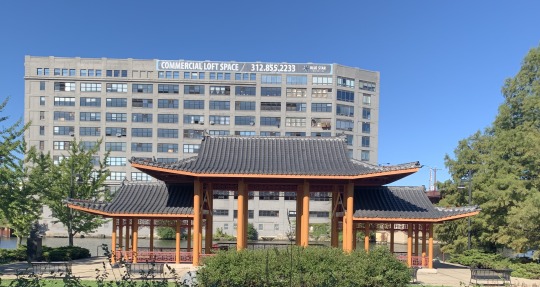
Pagoda pavilion in Ping Tom Memorial Park
The Ping Tom park was truly a hidden gem and a pleasant escape from the industrial and urban environment Chicago creates. Although the entrance is a bit peculiar, any person attending the park will undoubtedly experience the beauty in the park. To note as well, was how surprisingly quiet the park was. Despite being surrounded by industrial infrastructure, the highway and rail line had a negligible impact on the park, but I must admit, on my first attempt at exiting the park I was prohibited from doing so due to a train.
To end my trip around the neighborhood I headed towards the Chinese-American Museum of Chicago to learn more about the origins of the neighborhood. Along my way I was able to see the Chinatown Gate, which symbolizes the entrance to Chinatown. The gate was constructed in 1975, designed to reflect similar characteristics to gates found in Beijing. The Chinese characters displayed atop the gate translate to mean, “the world belongs to the commonwealth” (Male, 2020). Chinatown Gate was implemented in order to promote increased unity and intensified cultural exchange in the neighborhood. The gate is quite spectacular and provides a grand entrance to Chinatown, a worthy entrance to a community full of rich culture and trade.

Chinatown Gate, 2206 S Wentworth Ave
Passing the gate, I arrived at the museum. The Chinese-American Museum mission preaches for the appreciation of Chinese-American culture by means of education and through exhibitions. The museum aims to preserve the history of the culture, as well as, the future (Chinese American Museum of Chicago, 2020). The museum was compiled on two floors. On the first floor, pictures, decorations, clothing, jewelry, and many other traditional Chinese artifacts were presented. What stood out to me most significantly were the wooden carvings hung along the walls. Traditionally known as the folk craft of Guangdong, carving styles illustrate flowery, layered scenes depicting generally historical events and legend. The Guangdong carvings located in the museum were massive, and it was apparent the laboring efforts required to create such a work of art.
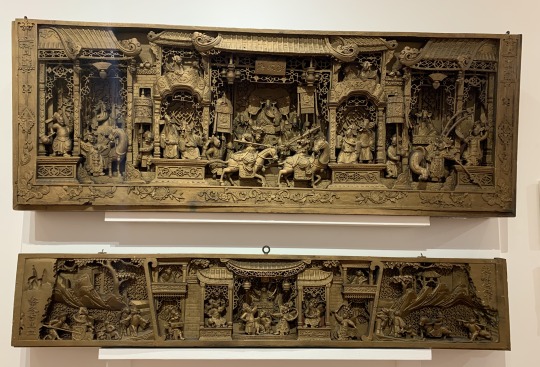
Guangdong carving in Chinese-American Museum, 238 W. 23rd St
On the second floor of the museum, a theatre can be located; in which a brief informational video is presented showcasing staple Chinese cultures and customs, along with discussing the historical founding of the neighborhood. The video was illuminating and educational, presenting the history of Chinatown quite well. Found on the second floor as well are depictions of successful Chinese-owned businesses. Early in their settlement to Chicago, the Chinese population discovered laundry services and facilities required little capital to start and the skills required were easy to learn. Because of these two factors within a span of fifty years the number of Chinese operated laundromats from two, in 1872, to nearly five-hundred, by 1926 (Chinese American Museum of Chicago, 2020). Displayed in the museum’s laundry are a manual cash register, a business license from 1959, as well as, typical laundry accessories, such as irons, sprayers, a darning machine, and spindles of twine.

Chinese laundry located in Chinese-American Museum
Beginning my trip I was unsure of what impression Chinatown would leave me with, after my first thorough visit. Initially I imagined Chinatown to be noisy and busy, with highways circling the neighborhood, and the red line ‘L’ track running on its boundary; but this was not my lasting memory of the neighborhood. As I explored more I was able to recognize the escape that Chinatown provides from Chicago. The New Chinatown Library provides excellent educational resources to the community, while also promoting the use of sustainable infrastructure in further development of the neighborhood. Chinatown Square and Mall stimulates the local economy for the neighborhood, simultaneously providing a gathering place for its residents. The implementation of Ping Tom Memorial Park was a much dire need for the community, providing green space and recreation. The Ping Tom park in my opinion provides the greatest experience of any park I have visited in Chicago. Chinatown is a deeply cultural neighborhood and this is extremely important and apparent as one walks through the neighborhood. As the pressures of gentrification and city development continue to trouble the existing community, it is crucial steps be taken to preserve the neighborhood. Although this is much to ask and prevent, small actions, like supporting a small business or leaving a donation at the Chinese-American Museum, can go to support the community and uphold the culture built in Chinatown.
Sources:
Chicago Park District. (2020). Ping Tom Memorial Park. Retrieved October 08, 2020, from https://www.chicagoparkdistrict.com/parks-facilities/tom-ping-memorial-park
Chinese American Museum of Chicago. (2020). History and Mission. Retrieved October 08, 2020, from https://ccamuseum.org/
Clark, A. (2016, February 22). The Unlikely Boom of Chicago's Chinatown. Retrieved October 8, 2020, from https://classroom.google.com/u/1/c/MTMwNzA5NjA3MDI0/a/MTcwMDU0NDEzMTc5/details
Ecker, D. (2019, May 10). The Battle for Chinatown's Future. Retrieved October 08, 2020, from https://drive.google.com/file/d/18pHBWRIsCneO6W04YBN1wJeWvXoIv7nS/vie
Kennedy, K. (2002, January 20). Chinatown returns to center stage. Retrieved October 08, 2020, from https://www.chicagotribune.com/news/ct-xpm-2002-01-20-0201200041-story.html
Kiang, Y. (1992). Chinatown. Retrieved October 08, 2020, from http://www.encyclopedia.chicagohistory.org/pages/284.html
Ling, H. (1956). Chinese Chicago: Race, Transnational Migration, and Community Since 1870. Stanford, California. ISBN 0-8047-8336-5
Male, M. (2020). Chinatown Gate, Chicago. Retrieved October 08, 2020, from https://www.gpsmycity.com/attractions/chinatown-gate-10226.html
Photos:
All of the photos illustrated throughout the blog were taken by me except for the following images:
Ping Tom bust:
https://slakingfool.blogspot.com/2010_09_01_archive.html
Chinatown Gate:
https://media.gettyimages.com/photos/chicago-chinatown-gate-picture-id558935993
1 note
·
View note
Text
Trip to Bridgeport
In the second week of Chicago excursions I was assigned to explore the neighborhood of Bridgeport. Bridgeport is located in the city’s south side, the neighborhood is confined to the north by the south branch of the Chicago river stretching south to Pershing Road. Laterally the neighborhood spans from the Union Pacific Railroad tracks in the east, to Bubbly Creek in the west. Bridgeport possesses the title as the oldest neighborhood in the city of Chicago, officially becoming Bridgeport Township in 1863. The history of Bridgeport and what survives today projects different stories about the neighborhood. Originally an Irish enclave of industry, Bridgeport today is ethnically diverse with many varying socioeconomic levels residing in the neighborhood.

Map of Bridgeport
Industry began to boom in Bridgeport around 1830 when Stearns’ Quarry established a limestone quarry, dynamiting in the neighborhood until 1969 (Bloom, 2020). Industrialization swallowed the area, by 1905 the first privately owned and managed industrial park was established, called the Central Manufacturing District. The owners of the park invested into the neighborhood, building roads, public emergency services, a bank, and even leisure businesses. The demographic composed today in Bridgeport one will find around two of five residents being Asian, and one of five residents being of Hispanic dissent (Statistical Atlas, 2020). Immigrants from the old world flooded Bridgeport in aims for a working job. The Irish flooded the neighborhood first, soon to follow were northern and eastern European immigrants. Important to the neighborhood during the beginning of the 20th century was the railroad construction nearby (Bloom, 2020). Many of the workers who recently migrated were Mexican, who established homes in the neighborhood (Bloom, 2020). The remainder of the 20th century and leading to modern day, Bridgeport witnessed many Asian immigrants moving to the area. Being within close proximity to the city’s long-standing, well-established Chinatown district. Also residing near the historic district of Bronzeville, the population consists of African American and Hispanic dwellers.
What was once a booming sector of industry, today Bridgeport is now a cultural center for art and diversity. The neighborhood although slightly large on scale, is entitled to a strong sense of community. This strong sense of community may be one such production of the deeply rooted religious structures seen very visibly throughout the neighborhood. Apparent to the neighborhood is its nonsecular nature, with many ornate and magnificent churches. Also clearly apparent in Bridgeport, is the neighborhood’s lust for art, specifically modern, urban art; two art centers stand just a stone’s throw apart from one another. To note as well is the neighborhood repurposing efforts to transition areas of industry into public spaces. Many parks are scattered throughout Bridgeport today. On my visit to the neighborhood I was able to explore one of these parks, also I witnessed a few churches, and was able to tour the neighborhood’s art center.
During the Friday excursion of the neighborhood, I began my day at the Bridgeport Art Center. The art center is located on 35th Street, at 1200 West 35th Street, in the central manufacturing district; once the location for the Spiegel Catalog warehouse. Established in 2001, the Bridgeport Art Center is focused to continuously serve as a resource for creative minds, and to be the beacon for the innovating Chicago art scene (Bridgeport Art Center, 2020). The art center is home to numerous artists, designers, and working professionals. Incredibly, I was fortunate enough and one of the first to attend the art center on the same day of its 4th Floor Gallery opening reception. The gallery’s newest theme entitled ‘Where’s the Revolution,’ is an exhibition featuring political art expressing varying points of view of global politics and social justice standards (Bridgeport Art Center, 2020). The exhibits displayed depict themes current to modern issues in America. At the forefront of the exhibits were criticisms of the current presidency, as well as the extremely salient movement of Black Lives Matter. In one work the artist depicts the final words of George Floyd, “I can’t breathe.” The artistic piece utilizes yarn on canvas to depict the final words, in the artist’s own words, “lives holding by a thread.” Many of the artistic works also present an underlying theme of police brutality targeted against racial minorities.
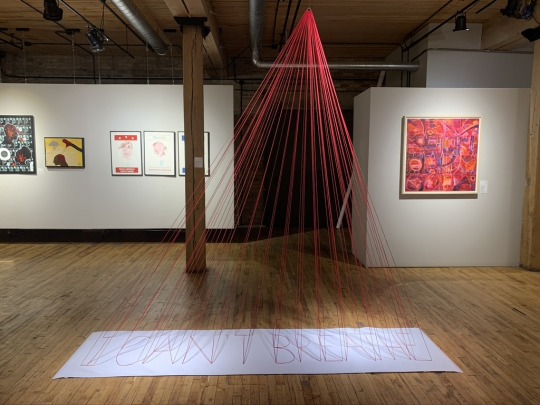
I Can’t Breathe by Pinar Aral

Floyd by Victoria Goite
Although the 4th Floor Gallery was fascinating to explore and witness, I was able to meet and discuss with internationally acclaimed Italian sculptor, Virginio Ferrari. During my walkthrough of the 4th Floor Gallery I was confronted by a waste management consultant who worked in the building. He thought it would be an advantageous opportunity to meet and have a dialogue with Ferrari. I agreed to his opportunity and he escorted me to Ferrari’s work space in the basement of the building.
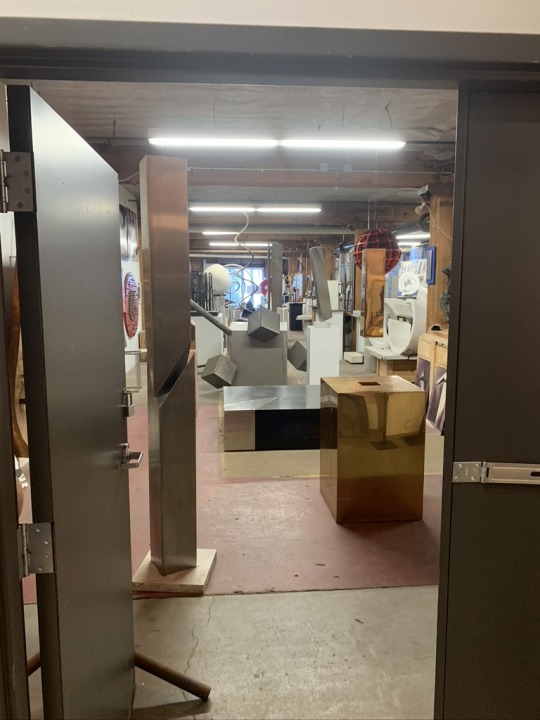
Virginio Ferrari’s Workshop in Bridgeport Art Center
I had the ability to have a personal tour of Ferrari’s shop by the man himself. He discussed his life story and beginnings of his artistic career. Mentored by his father and grandfather in the trade of stone cutting, Ferrari learned respect for the craft, and has continued his family’s legacy since. Ferrari is an immigrant of Italy who migrated to Chicago in the 1960s. After his migration to Chicago, Ferrari would serve for one decade as the Assistant Professor of Art and Sculptor in Residence, at the prestigious University of Chicago (Ferrari, 2020). Ferrari has thirty monumental pieces alone in Chicago, and other works can be witnessed all over the world, with sculptures located in Europe, Asia, and throughout the continental United States. Some of his most notable works found in Chicago include the Being Born exhibition near the Ohio Feeder Ramp in Riverside North, as well as the controversial exhibit Dialogo, which casts a shadow annually on May Day that depicts the Communist sickle and hammer (Ferrari, 2020). Even at the age of eighty-three year, Ferrari is still active with his craftsmanship, constantly creating new sculptures in his Bridgeport workspace.
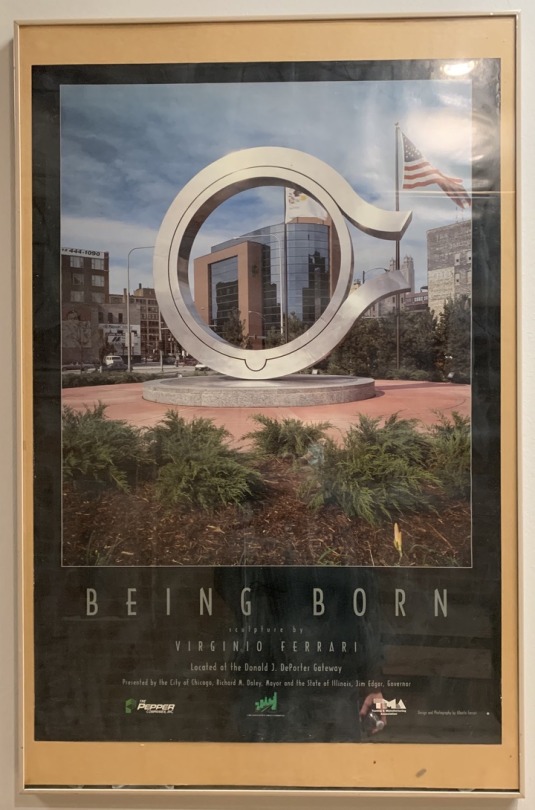
Being Born by Virginio Ferrari
Although the opportunity to meet the world renowned sculptor, Virginio Ferrari, was incredibly exciting, there was still more to see of the neighborhood. After my visit to the Bridgeport Art Center, I continued my morning walkthrough of Bridgeport by viewing a couple of churches located in near proximity. The first church I was able to visit was the Roman Catholic Church of St. Mary of Perpetual Help. This church has been standing in Bridgeport since 1882 (St. Mary of Perpetual Help Church, 2020). Its establishment was influenced by the growing Polish immigrant population in the area. It served as a community home for these Polish immigrants, and still serves today as the parish for the Catholic girl high school, De La Salle Institute. The building itself is magnificent with elaborate towers and a colossal dome, with intricate detailing found all over the building.
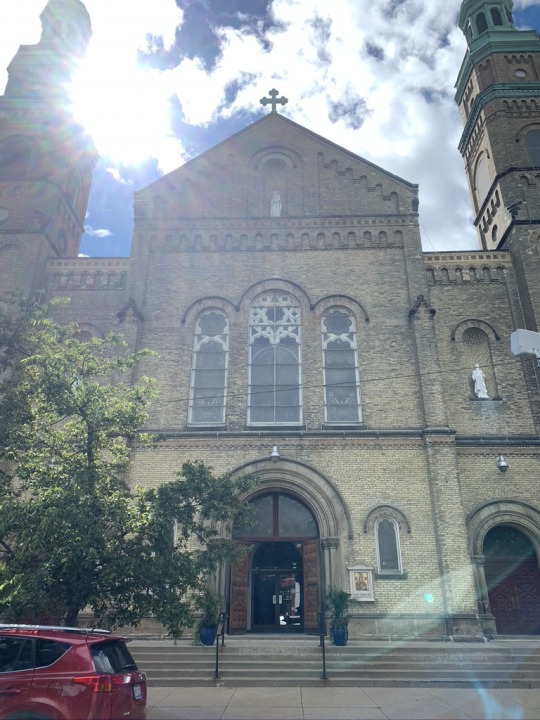
St. Mary of Perpetual Help Church, 1039 West 32nd Street
After my walk by the St. Mary Church, I was able to see the Monastery of the Holy Cross. This monastery was established a century later than the previous parish discussed, in 1988. Although the monastery was established in 1988, the building in which the monastery resides was once the home of a Polish parish, the Immaculate Conception Church (Monastery of the Holy Cross, 2020). The Monastery of the Holy Cross was founded by three missionary priests who sought out to combat the challenges of evangelization in the modern world (Monastery of the Holy Cross, 2020). The priest's mission was evangelization of the modern ‘desert’ of the city, which faces issues of violence, alienation, and spiritual poverty (Monastery of the Holy Cross, 2020). To comment on the building, the monastery is found at the location of the former Immaculate Conception church. The building although simple in design, with a only singular vertical turret attached, is known for its beauty. The sheer height of the tower was quite remarkable to witness in person.

Monastery of the Holy Cross, 3111 South Aberdeen Street
As the end of my trip neared, I decided to visit one of the local parks in the neighborhood. Located at 2700 South Halsted Street, in the heart of the Bridgeport neighborhood, I was able to visit the Palmisano Park and Quarry. Prior to the park, the area was most well known for the Stearns’ Quarry, in which massive amounts of limestone were extracted from the earth. This twenty-six acre site offers a bountiful amount of activities for visitors to enjoy. The park includes a fishing pond, interpretive wetlands, preserved quarry walls, trails, an athletic field, a running track, and over one and a half miles of walking trails (Chicago Park District, 2020). The park itself was gorgeous to walk around. It provided an incredible view of the Chicago skyline, and most notably preserves the land of the neighborhood. This park was very refreshing to experience. Being in the city can be overwhelming with the lack of green space, but the Palmisano Park adds a much needed escape from the urban environment. It is hard to imagine, but the natural landscape of Chicago is composed of a marsh, and this is made very apparent through the park. Tall grasses and a pond were just two obvious features of the park displaying marsh characteristics. It was a pleasant surprise to discover this park. Even though I have been living in the area for two years now, it was exciting to explore a new green space in close relation to my university.
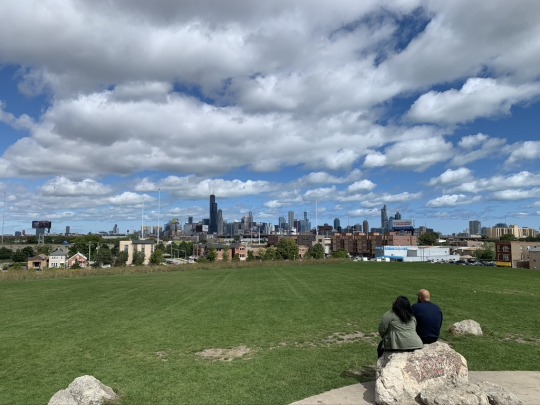
View of Chicago Skyline from Palmisano Park
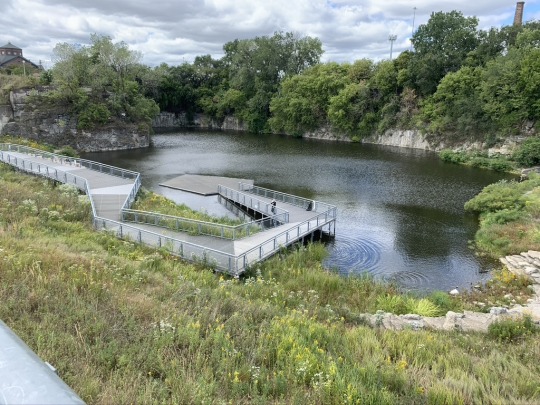
Fishing Pond at Palmisano Park
Looking back on my trip to Bridgeport, the neighborhood is a multicultural enclave in a new emerging art scene. The oldest neighborhood of the city of Chicago surprised me with its numerous cultural identities. Initially founded by mainly Irish immigrants, the neighborhood has transformed its identity through the inclusion of other minorities. Immigrants from Mexico and Asia have built a new home for themselves in the neighborhood. The city in its past has been considered segregated, but this was not the impression I felt during my visit to the neighborhood. Bridgeport if anything, is a hub of acceptance and integration, consisting of many varying cultural and ethnic backgrounds. Made apparent by the religious institutions littered around the neighborhood, Bridgeport is a melting pot of culture, history, and art. Some individuals debate whether or not Bridgeport is the next ‘hipster’ neighborhood. I think that Bridgeport has the potential to grow to be this hipster hub. With two art centers already established in the neighborhood, along with a collection of unique restaurants, and public spaces for neighborhood residents to enjoy; Bridgeport, although the oldest neighborhood, is still transforming and staying up-to-date with cultural and social activities. I would recommend any visitor of Chicago to explore Bridgeport. As illustrated previously throughout this post, the neighborhood is compiled of varying commercial, religious, residential, and public spaces. Also home to the Chicago White Sox, the neighborhood offers plenty of activities for visitors to expierence. Bridgeport is a neighborhood of detailed and extensive history, but it is still transforming to serve the needs of its people.
Sources
Bloom, J. G. (2012). Images of America: Bridgeport. Retrieved September 25,2020, from https://www.google.com/books/edition/Bridgeport/JpjWCdLKyzEC?hl=en
Bridgeport Art Center. (2020). 4th Floor Gallery. Retrieved September 25, 2020, from https://bridgeportart.com/
Ferrari, M. G. (2020, September 02). Virginio Ferrari Foundation. Retrieved September 25, 2020, from https://virginioferrarifoundation.org/
St. Mary of Perpetual Help Church. (2020). History. Retrieved September 25, 2020, from http://www.stmaryofperpetualhelp.com/p/history-of-our-church.html
Monastery of the Holy Cross. (2020). Our History. Retrieved September 25, 2020, from https://chicagomonk.org/about-us/our-history/
Chicago Park District. (2020). Palmisano Park. Retrieved September 25, 2020, from https://www.chicagoparkdistrict.com/parks-facilities/palmisano-henry-park
Statistical Atlas. (2020). Race and Ethnicity in Bridgeport, Chicago, Illinois. Retrieved September 25, 2020 from https://statisticalatlas.com/neighborhood/Illinois/Chicago/Bridgeport/Race-and-Ethnicity
Photos
All of the photos illustrated throughout the blog were taken by me except for the following images:
Map of Bridgeport:
https://www.google.com/books/edition/Bridgeport/JpjWCdLKyzEC?hl=en
1 note
·
View note
Text
Trip to Bronzeville
Recently I was able to tour the historic neighborhood of Bronzeville, located in Chicago’s south side. Stretching from 31st Street south to Pershing Road and elapsing laterally from the lakefront westward to the Dan Ryan expressway. This neighborhood cements its storied past during the Great Migration, a period of time in the United States, in which seven million African Americans emigrated from southern rural states to the urban cities of the north (Grossman, 2005). Due to social differences the growing African American population was mainly independent from the existing Chicago population. Thus an African American enclave was born, and the community created independent economic, social, and political functions. These functions would generate the success that eventually led to the ‘Black Metropolis.’ The metropolis constructed by these newly immigrated African Americans was considered a city within a city, offering services that were turned off to many African Americans.

Map of Bronzeville
Prior to the turn millennium, in 1998 the city named nine historic landmarks as significant to the once thriving Black Metropolis. The nine named include: Unity Hall, the Chicago Defender Building, Sunset Cafe, the Eighth Regiment Armory, the Supreme Life Building, Victory Monument, the Overton Hygienic Building, the Chicago Bee Building, and the Wabash Avenue YMCA (Faye, 2015). Of the previously listed nine landmarks, I was able to visit four on my visit of Bronzeville, and a few other sites that find historical significance.
I began my journey to Bronzeville at the intersection of 35th Street and Dr. Martin Luther King Drive. King Drive once entitled Grand Boulevard was originally engineered as part of the Chicago park and boulevard system. The park and boulevard system was designed to provide bicycle riders an enhanced transit system for greater ease around the city. The park system also solved an issue of escape for city dwellers. Prior to the implementation of the park and bike system, so commonly vital to the city today, those living in the city would retreat to cemeteries for green spaces (WTTW, 2010). The park system produced and protected needed green space to the urban environment. Standing today at the crossroads of King Drive and 35th Street are many historical sightings for onlookers to appreciate. I was able to visit three significant sites at this intersection of the neighborhood alone, two of which the city deems significant to the metropolis.
The most obvious of the three sites was the large monument standing in the middle of King Drive. Victory Monument is the large structure that stands honoring the accomplishments of the neighborhood’s military regiment for their service in World War I. The Eighth Regiment, an all African American unit, provided heroic services for the allied forces during the Great War (City of Chicago, 2020). The unit has a special claim as the final regiment to evacuate German forces from the Aisne-Marne reign in Belleau, France, prior to the Armistice (National Park Service, 2020). The monument was dedicated on Armistice Day of 1928, and the soldier seen on top was added later in 1936.

Victory Monument
In relation to Victory Monument is one significant site I have passed many times and have paid little attention too. Just east of Victory Monument, now where stands the Chicago Military Academy of Bronzeville, a public college preparatory academy. The building this academy claims rights to today was once built as an armory for the first African American military regiment in 1915 (National Park Service, 2020). The armory established a home for the Eighth Regiment, also commonly referred to as the ‘Fighting Eighth.’ The same regiment honored by Victory Monument. This branch was designed to act as an infantry division for the Illinois National Guard. As touched on previously, this legendary African American regiment is one of the nine defining sites of the Black Metropolis.
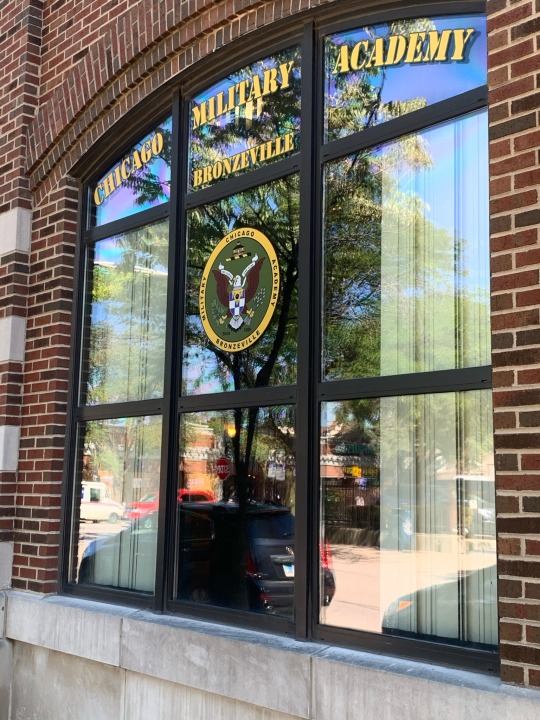
Chicago Military Academy, or once Eighth Regiment Armory
The next landmark I was able to observe is one in which a nonobservant eye may miss. While approaching Victory Monument if you are to look down on the walkway leading to the monument; stars can be seen, each inscribed, remembering a noteworthy individual to the neighborhood. This landmark is the Bronzeville Walk of Fame, highlighting the most notable African American residents of the neighborhood. I was able to witness four plaques, the first honoring Colonel Franklin A. Denison, the commander of the historic Eighth Regiment and also the Assistant Attorney General of Illinois. The second person memorialized is Lieutenant George R. Giles, who is remembered as a hero of the Great War. The following name enlisted upon the walk relates to another landmark during this excursion, more specifically the Supreme Liberty Life Insurance Company. The two men remembered are Truman Gibson Sr. the founder of the historic African American financial business, and his son Truman Gibson Jr. an influential civilian aide to the Secretary of War during World War I. The final impactful person on the Walk of Fame is Major Robert H. Lawrence Jr. the first African American astronaut. Although the five men previously listed all accomplished great accomplishments that the neighborhood holds intimately, the Walk of Fame includes many other important figures to Bronzeville. The Black Metropolis was an economic and cultural haven for African American immigrating to the north, seducing the interest of many other famous professionals including Louis Armstrong, Ida B. Wells, and Bessie Coleman, just to list a few.
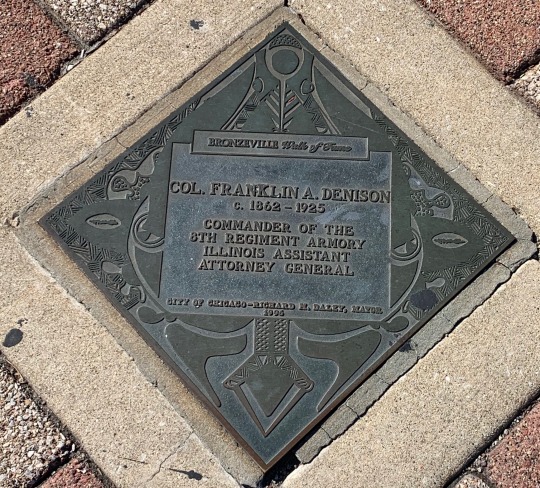
Bronzeville Walk of Fame, Colonel Franklin A. Denison
As touched on previously Truman Gibson Sr. was the founder of the Supreme Liberty Life Insurance Company. Although Gibson Sr. has passed on the building in which his business inhabited still stands today. Identified as one of nine landmarks with historical significance to the neighborhood, I was able to observe the building. The extensive African American history found in Bronzeville can be witnessed through the Supreme Life Company, the insurance company was the first of its kind, being the first black owned and operated company in the north (City of Chicago, 2020). It holds such significance in history because during a time of great racial tension, African Americans were turned away from common city lenders. Because of this the Supreme Life Insurance Company was able to serve to a market that was untapped. Once financing the expansion of the neighborhood, business and social functions boomed in Bronzeville, creating the isolated enclave renowned for its service to the African American community.

Supreme Life Insurance Co. Building
Later in the day during my trip to Bronzeville, I walked east toward the lakefront, until I reached the Stephen A. Douglas Tomb. Born in Vermont, and later journeying to Illinois to establish a practice of law. Douglas would serve on the Illinois Supreme Court prior to his seat in the House of Representatives. Although accomplished, Douglas may be most well known from his debates for the Illinois Senate seat in 1858 with at the time an unknown opponent, Abraham Lincoln (History.com Editors, 2018). The two had a series of debates arguing the issues of the time, most importantly slavery and the potential practices of expansion for the trade. Douglas would best Lincoln, and continue a third term as senator. Bronzeville and Douglas find relation with one another as the land the neighborhood claims was once owned by Douglas. In 1852, the senator bought seventy acres in Chicago, establishing an early University of Chicago, and even using part of the land as a Civil War camp that once housed Confederate prisoners of war (WTTW, 2010). The tomb erected for Douglas is quite simple, with a singular slim tower, being surrounded by four pillars, each presenting a different word. The four pillars list the words: eloquence, justice, history, and Illinois. Transitioning to modern social issues, some members of the neighborhood view the tomb for Douglas as disrespectful to the African American community. Because of his views on slavery, many believe the memorial symbolizes a man who did not envision equality for all. Political issues aside, the tomb was fascinating to witness in person, and the ornate detail that can be appreciated only added to the experience.
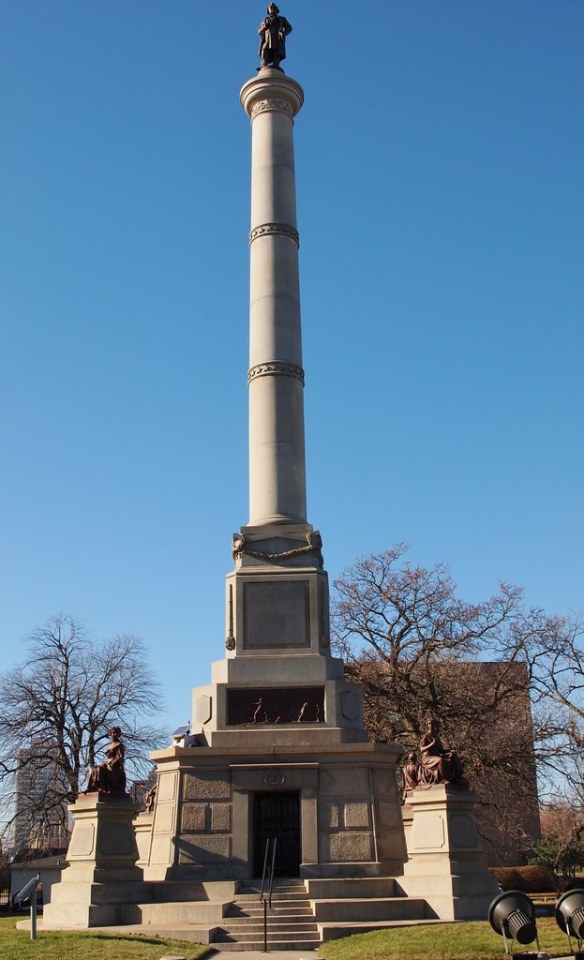
Tomb of Stephen A. Douglas
As the end of my trip approached I was encouraged to visit a landmark not far from the very university I attend. The Overton Hygienic Building is well known from its pioneering owner Anthony Overton. Anthony Overton was the founder of numerous business ventures, including Overton Hygienic, Douglas National Bank, Victory Life Insurance Company, Great Northern Realty Company, and a famous African American newspaper, The Chicago Bee (African American Registry, 2020). Most significant to Overton as a businessman, is he was the first African American to establish a major conglomerate. Overton built his fortune through cosmetics, specifically targeting the needs and complexions of the African American women. The Overton business empire was incredibly salient to the growth of the neighborhood, and without Anthony Overton’s investment in Bronzeville the landscape may look vastly different than what stands today.
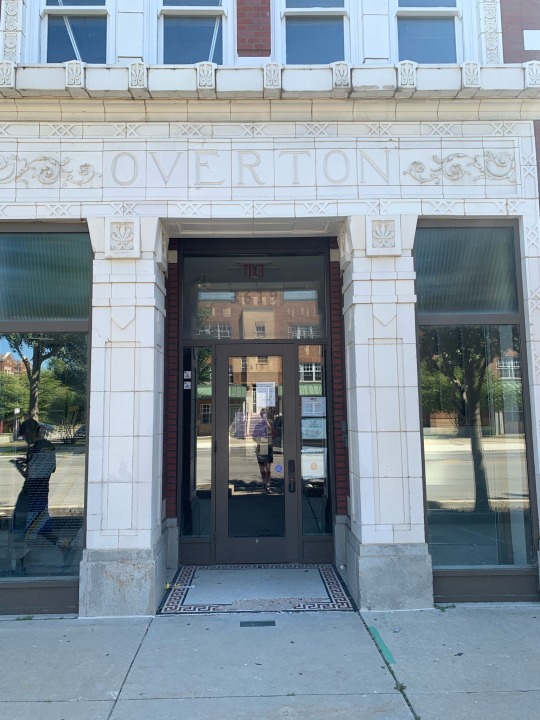
Overton Hygienic Building
I would amalgamate all my experiences throughout my trip to Bronzeville as extremely mind opening. During my trip I would find myself repeatedly caught off-guard by buildings that were deemed as historical landmarks, but structures I have glazed over without appreciation. Being in my third year at the Illinois Institute of Technology, it somewhat pains me to learn so late of all the history the neighborhood has to present. Incredible and something I found unique to the neighborhood were the numerous murals, artwork, and pictures scattered throughout, even the local Mariano’s displays photos along its windows of an early Black Metropolis. Each of these artistic expressions displayed Bronzeville's historic past, honoring the African American community that built the neighborhood that survives today. These expressions most importantly value and continue the African American culture that Bronzeville holds so dear to itself. I would recommend anyone unfamiliar with the history of the neighborhood to explore how Bronzeville grew to the ‘Metropolis’ it once was; booming with African American focused economic, social, and political development.
Sources
African American Registry. (2020, January 01). Anthony Overton, Business Pioneer. Retrieved September 11, 2020, from https://aaregistry.org/story/anthony-overton-business-pioneer/
City of Chicago. (2020). Supreme Life Building. Retrieved September 11, 2020, from https://webapps1.chicago.gov/landmarksweb/web/landmarkdetails.htm?lanId=1431
City of Chicago. (2020). Victory Monument. Retrieved September 11, 2020, from https://webapps1.chicago.gov/landmarksweb/web/landmarkdetails.htm?lanId=1444
Faye, M., & Pugh, R. (2015, July 01). Chicago Landmarks. Retrieved September 11, 2020, from https://magazine.iit.edu/summer-2015/chicago-landmarks
Grossman, J. (2005). Great Migration. Retrieved September 11, 2020, from http://www.encyclopedia.chicagohistory.org/pages/545.html
History.com Editors. (2018, August 21). Stephen A. Douglas. Retrieved September 11, 2020, from https://www.history.com/topics/us-politics/stephen-a-douglas
National Park Service. (2020). Eighth Regiment Armory. Retrieved September 11, 2020, from https://www.nps.gov/nr/travel/chicago/c18.htm
WTTW (Director). (2010, November 29). Biking the Boulevards with Geoffrey Baer [Video file]. Retrieved September 11, 2020, from https://video.wttw.com/video/geoffrey-baer-tours-biking-the-boulevards-with-geoffrey-baer/
Photos
All of the photos illustrated throughout the blog were taken by me except for the following images:
Map of Bronzeville:
https://oluduro.files.wordpress.com/2015/04/map.jpg
Park and Boulevard Map :
https://www.lakeviewhistoricalchronicles.org/2014/11/the-missing-link- diversey.html?m=1
Stephen A. Douglas Tomb:
https://live.staticflickr.com/8597/15318378834_239bb14d4c_b.jpg
2 notes
·
View notes